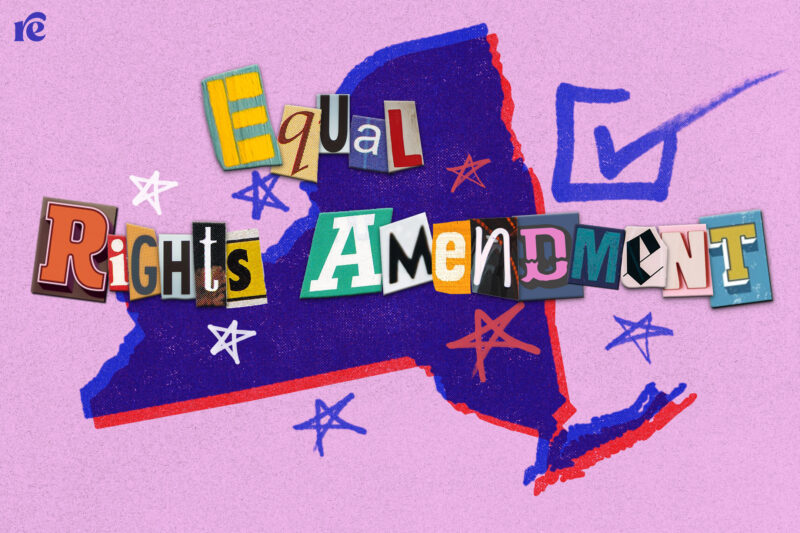What You Need to Know About New York’s Equal Rights Amendment
After being volleyed back and forth by New York judges, the state's Equal Rights Amendment, which would codify abortion rights, is back on the November ballot.

In June, a New York appeals court unanimously ruled to keep the Equal Rights Amendment on the November ballot after a state Supreme Court judge had tossed it in May. If voters pass the ERA, the amendment will be added to the state constitution and will offer expansive protections against discrimination based on ethnicity, national origin, age, disability, and sex—inclusive of sexual orientation, gender identity, and gender expression—and, notably, pregnancy outcomes and reproductive autonomy, among others.
Codifying the ERA to the New York Bill of Rights would be the first time a state constitution explicitly states sex discrimination includes discrimination based on a person’s pregnancy or pregnancy outcome, according to the NYCLU.
New York state Sen. Elizabeth Krueger, who co-sponsored the bill in 2022, has worked to bring the ERA to voters for the past five years. She told Rewire News Group the ERA could have been put on the 2023 ballot, but she decided to wait for the 2024 presidential election, which is expected to have a much higher voter turnout.
“We need this to pass because, as we have learned, state by state, we’re all under attack,” Krueger said. “Each state is gonna have to go down their road alone, because we’re not going to be able to count on the federal system.”
Krueger said she will lead a virtual presentation closer to the election to help educate voters about the ERA.
The process of enshrining these protections in the state constitution began with both chambers of the state legislature passing the ERA in two consecutive sessions. The state senate and assembly voted to pass the amendment on July 1, 2022, and again on January 24, 2023. The decision to place the ERA on the ballot was challenged in early May 2024 by state Supreme Court Justice Daniel Doyle, a Republican who issued a lawsuit in Livingston County in western New York.
Andrew Taverrite, communications director and senior adviser for New Yorkers for Equal Rights, a ballot initiative committee made up of civil and reproductive rights organizations advocating for the ERA’s passage, said Doyle’s decision wasn’t surprising, given that the anti-abortion movement is doing everything it can to block ballot measures that protect abortion rights.
“Anti-abortion politicians have been working in courthouses across the country to use the judiciary to take away power from the people, blocking abortion access, blocking reproductive freedoms,” Taverrite said. “They went judge shopping. They wanted to ensure that New Yorkers didn’t even have a chance to vote on this amendment come November.”
Attorney General Letitia James’ office appealed Doyle’s decision, and a panel of judges from a New York appeals court heard the case. The judges said those who filed to block the ERA missed the deadline to bring a lawsuit, and it reinstated the measure to the ballot on June 18.
“It’s critical that the voters vote yes on the New York Equal Rights Amendment because we need to close those loopholes in the state constitution.”
– Bonyen Lee-Gilmore, vice president of communications at the National Institutes for Reproductive Health
Currently, New York’s state constitution only protects against racial and religious discrimination, and all other state measures to protect equal rights are at the whim of who’s in office. ERA protections would be able to withstand any future changes to political leanings in the state government.
Bonyen Lee-Gilmore, vice president of communications at the National Institutes for Reproductive Health—one of the organizations within New Yorkers for Equal Rights—said conservative lawmakers’ attacks against the ERA show that they believe their agenda is counter to what voters actually want.
“It’s very telling that they don’t want voters to go to the ballot and they don’t want voters having a say in what their state can and can’t protect,” Lee-Gilmore said. “We don’t want to leave our rights and freedoms up to the changing political winds. … It’s critical that the voters vote yes on the New York Equal Rights Amendment because we need to close those loopholes in the state constitution.”
In a recent Politico article, ERA opponents were quoted saying that the amendment could weaken statutory rape laws, let minors receive gender-affirming health care without parental consent, and allow minors to purchase age-restricted products like alcohol, among other age-related arguments. Lee-Gilmore said the ERA will not have those effects and that these scare tactics are all disinformation.
“They want to confuse people,” Lee-Gilmore said. “They want to go after people’s fears, and any sort of misconceptions that people might hold about health care, reproductive health care, gender-affirming care, all of that.”
Krueger said the disinformation campaign against the ERA is the biggest challenge to getting the amendment passed by voters.
“They’re going down that road because they know that in New York state, they can’t win a fight saying, ‘We don’t want abortion,’” Krueger said. “So while they’re pretending this isn’t really about abortion, the money is all coming from the anti-choice funding community.”
Leading up to the November election, New Yorkers for Equal Rights is working with 270 groups across the state to build support for the ERA among voters, according to Taverrite.
“We have broad support across partisan lines [and] ideological lines,” Taverrite said. “That’s not something you see every day, and it’s something we’re really excited about. So we’re going to be getting out to speak to all New Yorkers across the state, making sure they know that their rights and fundamental freedoms are on the ballot in November, and to get people to vote yes.”
